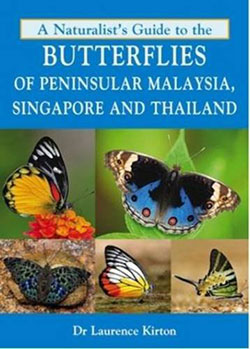Book Review (A Naturalist’s Guide to the) Butterflies of Peninsular Malaysia,
Singapore and Thailand
By Laurence G. Kirton (2014)
 176 pages; matt art paper, with 404 colour photographs (including front & back covers), 2 maps and 1 technical illustration.
176 pages; matt art paper, with 404 colour photographs (including front & back covers), 2 maps and 1 technical illustration.
Soft Cover. 18cm x 12.8cm.
ISBN 978-1-906780-90-6
John Beaufoy Publishing Limited UK.
Recently on my way to Borneo from Kanchanaburi (West Thailand), I found myself in Bangkok with a couple of days spare as a prearranged meeting failed to take place due to the flight cancellation from Europe of the party I was meant to meet. So I made my way down to Asia Books on Sukhumvitt Road and purchased this and a couple of other books to read to help pass the time.
This particular book turned out to be a very good purchase. It is a very useful little book full of nice quality, clear and in focus colour photographs. The opening introduction and short following chapters on geography, climate, vegetation, habitat, defense against natural enemies, life history (cycle) and seasonality are very informative and the author has done a very good job at explaining in simple terms the different types of forest and their structures and the diversity of butterfly species within those microclimates.
This is followed by two short sub chapters; ‘The Butterfly Body and Wings’ and ‘Classification and Names of Butterflies’ which are also well written and informative. It then moves onto advice on where to observe butterflies in the wild within this specific region and opportunities for research and study by naturalists, before launching into the main section of the book where the bulk of the species are illustrated and described. In all 470 species are covered with 280 of them beautifully illustrated with very nice quality photos. There are a total of 404 photos throughout the book and many of them at close quarters.
The species are grouped under common group names such as ‘Swallowtails’, ‘Whites & Sulphurs’, ‘Blues’ and ‘Skippers’ etc. which are further divided into subgroups. At the beginning of each group or sub-group there is a ‘very brief’ description of the group and perhaps not that useful in some cases, as the information is indeed limited and no doubt should have been expanded.
The specific species included are however a different story. They are well detailed and illustrated and include the common name followed by the scientific name and average forewing size. This is enhanced by a reasonably good but brief physical description, global distribution, regional subspecies and ‘habits and habitat’. The book concludes with a chapter on classification with tables outlaying the super families, families, subfamilies, tribes and genera.
The author on numerous occasions, mostly in the opening chapters, subtly points out the very negative effects logging brings about not just to the function of the environment as a whole but also the loss of species due to habitat destruction and that in fact, the Lepidoptera are very good visual indicators of environmental health.
Overall this is a very good book for what it is and definitely good value for money. I believe it retails for around $16-20 (Australian). I can thoroughly recommend this book as a good general identification and field guide for the nonscientific community including visitors and tourists to the region.
Rod Rice
Principal Reviewer
Nature & Travel Books
